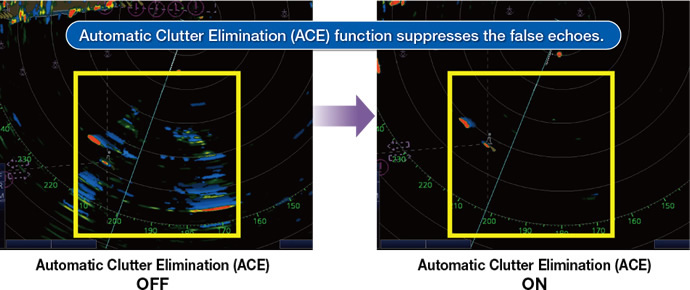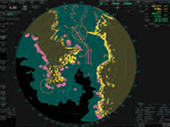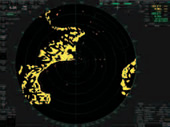Features
- Automatic Clutter Elimination (ACE) function provides clear echoes
Users can quickly adjust the radar image with a single action. When Automatic Clutter Elimination (ACE) function is activated, the system automatically adjusts the clutter reduction filter and gain control according to the sea and weather conditions selected (Calm/Rough Sea/Hard Rain).
Our advanced echo averaging architecture is also incorporated into Automatic Clutter Elimination (ACE) function. Users can avoid complicated adjustment processes, resulting in clear echo images.
 FURUNO’s Solid State Radar technology generates clearer echo images, which allows users to obtain clearer picture of what are around their vessel, including weak targets from small craft.
FURUNO’s Solid State Radar technology generates clearer echo images, which allows users to obtain clearer picture of what are around their vessel, including weak targets from small craft.
- Improved Target Tracking (TT) function
- Target acquisition takes only a few seconds
- Acquired target does not jump to adjacent target
- Reliable and stable tracking of high-speed and rapidly maneuvering vessels
- Advanced Interference Reduction (IR) function
Target Echo does not become smaller even with IR on
- 26” Wide LCD monitor compatibility
- Complies with the following regulations:
- IEC62388 Ed. 2.0
- IEC61162-1 Ed. 4.0
- IEC61174 Ed. 3.0
- IEC61162-2
- IEC62288
Multifunction display (MFD) capability*
FURUNO offers workstations that combine flexibility and redundancy. Users may easily select ECDIS, Chart Radar, Conning display or Alert Management System at any multi-function display. Navigators will enjoy reduced workload and significant freedom to move about the bridge. All necessary information is available on a variety of displays and at locations that may be altered as required.
*MFD capability is to be implemented as software update
 Radar (Chart ON)
Radar (Chart ON) Radar (Chart OFF)
Radar (Chart OFF) ECDIS
ECDIS Conning Information Display
Conning Information Display
Sensor Adapter
- Common sensor adaptor makes installation and maintenance easy
The Sensor Adapter acts as a central medium to gather all of the sensor data and collectively feed it to all FAR-3000 Chart Radar and FMD-3200/3300 ECDIS in the network. Since the sensor adapter can be extended to interface with all the sensors within the network, individual cable connections in the sensor-to-Chart Radar/ECDIS interface can be greatly reduced.
Navigation sensors can be directly interfaced with the processor’s 8 serial I/0 ports. Sensor adapters are required under the following conditions
- The sensor data is to be shared amongst multiple networked Chart Radar and ECDIS systems,
- The number of sensors interfaced is more than the number of the ports the processor has (8 serial I/O ports, 1 digital IN and 6 digital OUT), and/or
- The networked sensors include analog sensors.
In order to integrate onboard sensors into the navigation network, the sensor adapter may be interfaced with the switching hub HUB-100 from which distribution of the sensor data throughout the network is possible. Alternatively, multiple sensor adapters may be interfaced via Ethernet to integrate onboard sensors for use in the shipboard network.